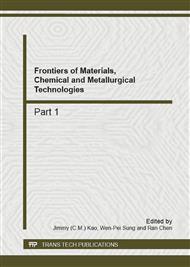p.467
p.471
p.475
p.479
p.483
p.487
p.491
p.495
p.500
Research on Effects of Annealing and Al Gettering on Electrical Properties of Upgraded Metallurgical Grade Multicrystalline Silicon
Abstract:
Annealing and Al gettering were performed on upgraded metallurgical grade multicrystalline silicon (UMG multi-Si) wafers with a purity of 99.999%. The dislocation and grain boundaries of samples were characterized by optical microscopy and electron back scattering diffraction (EBSD), respectively. The minority carrier lifetime and resistivity of the Si wafers were measured using microwave photoconductance decay and four-point probe techniques, respectively. The results show that the number of dislocations in Si wafers reduced obviously after annealing and Al gettering for 2 hours at 600~1100°C. The proportion of Σ3 grain boundary increases. But the minority carrier lifetime and resistivity of the Si wafers after annealing decreases. However, the minority carrier lifetime and resistivity of the Si wafers after Al gettering increases firstly and then decreases with increasing of the annealing temperature. It is considered that the metal impurities determine electrical properties of UMG multi-Si wafers rather than dislocations and grain boundary. However, Al gettering can enhances the properties of Si wafers effectively and the optimal effect of Al gettering has been achieved at 800°C.
Info:
Periodical:
Pages:
483-486
Citation:
Online since:
October 2012
Authors:
Price:
Сopyright:
© 2012 Trans Tech Publications Ltd. All Rights Reserved
Share:
Citation:


